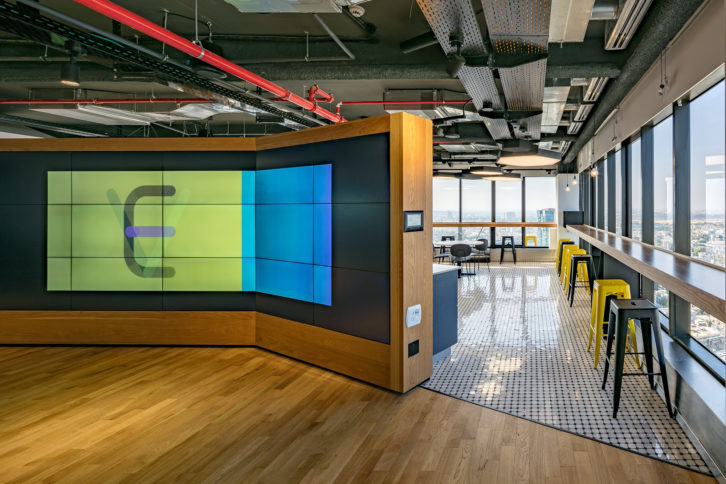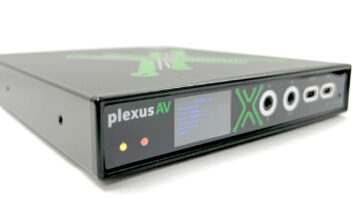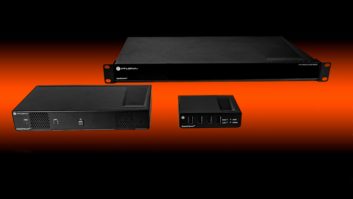
The past 15 years have witnessed a phenomenal transition in the professional AV world as more and more end users have discovered the benefits of embracing fully networked environments. This transition has been assisted by the introduction of a number of standards initiatives that both ease the development of new products and provide reassurance for end users stepping into this brave new world.
Most recently, these efforts have yielded the SMPTE ST 2110 standards suite, which specifies the carriage, synchronisation and description of separate elementary essence streams over IP for real-time production, playout and other professional media applications. Although much of the media attention to date has focused on ST 2110’s role in the broadcast industry’s move from SDI to IP, SMPTE also alludes to applications including theme parks (show control, image and sound), museums (large audio/video displays), large-scale digital advertising in public places, and live event production, including show control, image, sound, video displays and pyrotechnics.
The phased publication of standards in the suite began in December 2017 and is ongoing, but at least one aspect of the group will be very familiar to pro-AV users since the audio element is based on the AES67 standard. First introduced in 2013 and most recently updated in 2018, AES67 enables a certain degree of interoperability between existing IP-based audio network technologies.
In this article, Installation will take a look at the impact of these latest standards, as well as some of the other current developments informing AV networking – not least the continuing desire of vendors to seek market differentiation by developing solutions that build on the foundation of these standards by adding all manner of time-saving, integrator-friendly features.
‘A single, common solution’
Matthew Goldman, SVP technology of MediaKind and past president of SMPTE, offers a succinct summary of the strengths of ST 2110 – and the pre-existing ST 2059 standard for synchronising video equipment over an IP network – in terms of encouraging adoption of IP-based operations.
“First and foremost, [there is] worldwide support for a single, common solution for the carriage of real-time professional media over IP,” he says. “The importance of global support cannot be overstated and enables the much-needed economies of scale that the broadcast and professional media industry requires to remain competitive and offer the kind of services that consumers want. Of course, we only have said support because of the benefits that the SMPTE ST 2110 and ST 2059 standards suites provide: many multiples of streams supported in the same physical media; flexible association of streams into desired groups of media; the leveraging of internet protocols, commodity server hardware and IP/Ethernet switches; being agnostic to the specific media format carried within; preserving inter-stream synchronisation; and providing reliable stream delivery.”
Noting the “extremely positive response” to ST 2110, Goldman stresses the underlying principle of leveraging “as much as possible off of best-in-class existing standards and specification, hence the use of the underlying internet standards from the Internet Engineering Task Force (IETF) and Ethernet and time protocol standards from the IEEE. The AES invested a tremendous amount of effort into defining an all-IP method for professional audio, and the SMPTE standards group determined that it met the criteria, with only a few tweaks required. The benefit to the install sector is that a common audio standard is used, which simplifies operations and staff training, and improves stability (due to its more substantial industry penetration).”
But Goldman is also keen to address “the most common misconception” around ST 2110 – namely, that it provides everything that is needed for an “all-IP” infrastructure. Rather, it should be seen an “essential part of the ecosystem, providing the mechanism for the delivery of real-time professional media streams over IP. However, in order to realise the true benefits provided by all-IP, many other standards and specifications are required. For example, auto-discovery and registration of new devices and logical media processing functions, connection control and management, and security.”
Keeping an open mind
Given that the standards landscape for pro AV is likely to remain fluid for some years yet, the challenge for many vendors is to both adopt standards as and when it is possible or useful to do so, while ensuring the inclusion of features that differentiate their products and help make the lives of integrators as stress-free as possible.
As a prominent manufacturer in its own right, and a long-time Full Member of AIMS, Matrox is well-placed to observe the transition. “On the M&E [Media & Entertainment] side, Matrox is a leading supplier of ST 2110 technology,” explains David Chiappini, vice president of research & development, Matrox Graphics. “We have been an early adopter and supporter of the technology, demonstrating some of the earliest working boards on 25GigE and being a major contributor at each of the AIMS [Alliance for IP Media Solutions] interoperability sessions in the past several years with our Matrox X.mio3 and Matrox X.mio5 family of network card products.”
Meanwhile, in February it was announced that Chiappini had been appointed chair of the new AIMS Pro AV Working Group. The purpose of this new group is to define an open standards approach to IP-based media in the pro-AV world, with the group set to evaluate and recommend existing standards and specifications from AES, AMWA, VSF, SMPTE, IEEE and IETF that have already been broadly adopted by the media and entertainment industry.
The group, says Chiappini, has been “tasked with promoting the adoption of one set of media over IP protocols for the professional AV and installed systems market. This group is already hard at work [in defining] an open standards approach to addressing the pro AV world’s move towards IP media based on the groundwork laid out in the M&E market. Currently, its efforts are focused on addressing pro-AV market-specific features including security, HDCP support for protected content and I/O control.”
Chiappini explains that out of this effort will emerge a single set of open standards and specifications specifically for AV over IP that: enables seamless transport of video, audio and data; includes both compressed and uncompressed streams; covers control, management and real-time applications; and delivers applications that are secure and reliable with ultra-low latency.
Cautious enthusiasm
In general, the mood among other vendors who spoke to Installation for this feature was one of cautious enthusiasm for recent standards efforts, albeit with the ability of their solutions to offer valuable additional features and ease-of-use frequently expressed.
ClearOne’s VIEW and View Lite ranges include encoders and decoders able to support applications ranging from simple distribution for digital signage to 4K or videowalls, all over one network. President and CEO Zee Hakimoglu says that the company has “a rich history of balancing industry standards along with its own technology. For example, on the audio side we have a number of Dante-equipped products, and this works alongside our own P-Link connections. There is a place for both in a single solution.”
The company’s VIEW solutions operate over standard Ethernet, but have been engineered in such a way as to make them “very easy to configure and to give reliable, predictable performance. So far, no video over IP standard allows us to create a similar, seamless experience that our customers need.”
Nonetheless, Hakimoglu describes ST 2110 as “interesting because it is already being used by broadcasters, so we know it’s reliable. It’s also helpful that the audio side uses AES67, so it is easy to connect to many professional audio products.”
Rob Muddiman is EMEA sales director of ZeeVee, whose ZyPer AV over IP distribution product family – including the ZyPer4K, ZyPerUHD and ZyPerHD IP encoders and decoders – supports uncompressed 4K, UHD, 1080p in a variety of form factors and input types. “In a general sense, we support efforts towards standardisation since it eliminates confusion and promotes the interoperability of components in a given system,” he says.
But continued educational outreach is critical to the adoption of AV over IP, implies Muddiman. “The larger integration companies have fully embraced AVoIP, in many cases because their customers are demanding it, and smaller firms need to get onboard – or be left at the station. The industry has come a long way in the last year, and there’s now a lot of education being provided. Once integrators are ready to accept it, I think they’ll find ample opportunities – from manufacturers, distributors and our industry associations – to get what they need.”
Standards and solutions
As the developer of the Dante networking technology, Audinate has been at the forefront of the networked AV movement for many years. In February the company achieved a significant new milestone with the launch at ISE 2019 of its Dante AV integrated audio and video networking solution, with the Dante AV Module supporting one video channel and eight bidirectional channels of uncompressed Dante audio.
“When we looked at the video over IP market it was very fragmented, with a wide variety of solutions with various bandwidth limitations, codecs, architectures and features,” says Joshua Rush, Audinate’s vice president of marketing and product management. “We thought there was a real opportunity to provide a unified solution for the industry like we have done on the audio side, and that is the role of the Dante AV Module.”
Dante is compatible with AES67. Rush remarks that “in general the various standards initiatives have been beneficial in that they provide a low-level path to interoperability between products that use various protocols. The challenging part has been educating integrators and end users about what these standards do and don’t do. Often times people assume that one of these standards will just automatically do everything that Dante does, but we’ve put considerable time and investment into making Dante more than just a base level way to route audio and video streams. Things like plug and play discoverability, native device naming, control software and now management tools like Dante Domain Manager all combine to make it very easy for customers to install and use Dante.”
As current and forthcoming standards achieve greater traction throughout pro AV, the need for vendors to offer significant features above and beyond the base level will remain acute. But many have already showed their credentials here to winning effect, and in general terms there is no doubt that accessible and concisely explained standards programmes are emboldening end-users and accelerating the transition towards fully IP-based operations.
www.audinate.com
www.clearone.com
www.matrox.com
www.mediakind.com
www.sdvoe.org
www.zeevee.com







